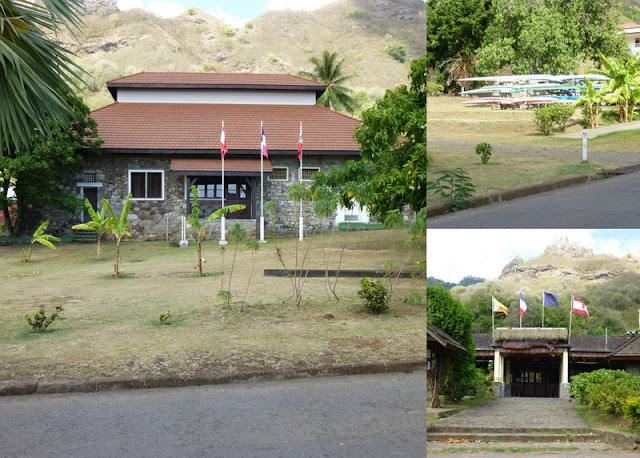January 12, 2013 anchored off Nuku Hiva, Marqueses
Islands, French Polynesia – The Real
Hawaiian Homelands -- Maybe
Another half-day at sea and at 1:00pm, we finally
anchored in Taiohae Bay (a sunken volcanic crater), Nuku Hiva. Nuku Hiva is not an atoll but was formed by
explosive volcanic activity, so it does not have a coral fringe or long, sandy
beaches.
It was our first sighting of land since leaving LA six
and one-half days previously. The
weather was still not being very cooperative.
It had rained earlier in the day.
By the time we were cleared to go ashore, it had stopped raining;
however, there was no sunshine, only horizon-to-horizon, low-lying, intermittent
clouds. The sun birds on board were
becoming ever more restless about the continued gray skies and rain
squalls. At least we were close enough
to the Equator that the temperatures were into the 80s but so was the humidity.
Land Ho!
Nuku Hiva Island
from seaward.
Entering Taiohae Bay
The bay is a
volcanic crater full of sea water.
We were looking forward to visiting Nuku Hiva, because
current theories on the origins of Polynesians in the Hawaiian Islands hold
that Hawaii was populated from the Marqueses by peoples sailing voyaging canoes
(similar to the Hoku Lea) to the island of Hawaii (The Big Island). Of course, a two-hour visit to one small
island does not confirm or deny such a theory, but it was interesting to visit
Nuku Hiva and walk the land that may have been the Hawaiians’ ancestral home.
During the War of 1812, American forces occupied Nuku
Hiva and built a stockade on a small hill on the bay. This stockade was named “Fort Jefferson,” and
it was manned by American forces for only 24 months. Then, it dawned on the Americans that the British
had absolutely no interest in challenging the American presence on the
island. Probably mostly out of boredom,
the Americans packed up and sailed away, having never fired a shot at the
British lion. For the mouse to roar, there must be someone to hear!
Site of Fort Jefferson from Taiohae Bay
Luckily, Francis
Scott Key wasn’t with this expedition.
Tendering ashore, we began our self-guided tour of
Taiohae, the largest village on Nuku Hiva and the French administrative center
for the Marqueses Islands. At the Marina Pier, where the tender tied up, we
were greeted by local dancers and musicians.
In addition, there were a number of other local musicians, dancers,
fishermen, and vendors standing around watching our arrival. It was all very casual; the ship’s passengers
seemed to provide that day’s entertainment for the locals.
Local Greeting Committee
Excellent
drumming, very casual and laid back.
The village is spread along one side of a single, paved
road running by the bay for a little over a mile. There is a cargo pier, French administrative
center, post office, police station, and two churches, one catholic and one
protestant. The tourism infrastructure
consisted of several pensions and a half dozen restaurants. Nuku Hiva may be on the tourism map, but it
is on the very edge.
The Beach and Beach Road
Not a lot of
congestion here. The horse is real.
Local Infrastructure
The local canoe
club seems to be alive and well.
We walked along the sidewalk next to the road, waving to
passengers in pickup trucks and offering good afternoon to locals walking along
the road. Spaced along the road were a
number tikis (most of which probably were
recently carved). The original tikis
were most likely destroyed by early missionaries, as happened to many of their
brothers on islands throughout Polynesia.
Tikis – Ancient and Modern
At least one
(upper left) seems to have almost escaped the missionaries.
There were also local handicrafts on display at a large
handicraft market near the pier (The Marqueses are renowned for wood carving). We were not tempted to drag a piece of carved
wood into our suite for the three-plus months remaining on the cruise.
The highlight of our tour was a visit to the protestant
church. We chose it because it was
closer to the pier than the Catholic Church and the furthest point that we got. There were many things that reminded us of
rural Hawaii, especially Kauai, including free-range, feral chickens and poi
dogs. At the pier, we watched local
families loading offspring, pets and produce into their pickups for the ride up
country.
Feral Chicken, Poi
Dog, and Goat Kid in truck.
Two hours after we came ashore, it was back on the tender
for the return to the Silver Whisper.
Luckily, we had timed our visit so that we avoided the rain that began
shortly after our return to the ship. At
6:00pm, we sailed for Rangiroa atoll in the Tuamotu Islands.









No comments:
Post a Comment